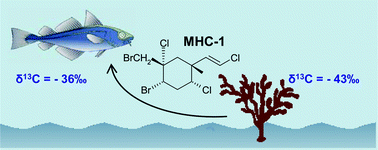Stable carbon isotope composition (δ13C values) of the halogenated monoterpene MHC-1 as found in fish and seaweed from different marine regions
Abstract
Six samples of the red seaweed Plocamium cartilagineum (two both from Helgoland/Germany, Ireland, and the Antarctic) were analyzed by stable isotope analysis. The bulk δ13C values (−31 to −38‰) confirmed that this seaweed was exceptionally highly depleted in 13C. The δ15N values were in the reported range for algae, and a moderate correlation between 13C and 15N content was observed. These measurements indicated that the season had a higher impact on the δ13C values than the location. Compound specific carbon isotope analysis by


 Please wait while we load your content...
Please wait while we load your content...